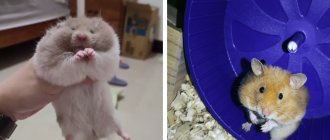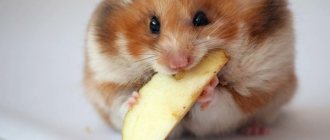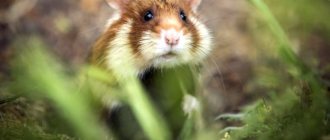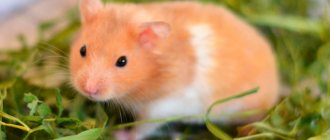№9
They have very poor eyesight. They suffer from myopia and, like many animals, see everything only in black and white. However, poor eyesight was replaced by an excellent sense of smell. Hamsters easily distinguish each other by smell and also easily recognize their owner by smell.
They are also sensitive to sounds. They can hear in the ultrasonic range.
In addition, they have sensory nerves at the ends of their antennae, which help them sense their surroundings and more easily navigate in the dark.
Diseases and their prevention
Unfortunately, any type of hamster is extremely vulnerable to many colds and infectious diseases. Some of these diseases extremely weaken the animal's body, which can ultimately lead to its death. Including a certain part of the diseases will be caused by improper conditions of detention, and not by the breed characteristics of the species.
We list the most common ailments of hamsters.
Obesity. A common disease among all pets. The reasons are irregular and plentiful feeding together with a sedentary lifestyle. That is why keeping hamsters requires a lot of free space for games and entertainment. In their natural habitat, these animals spend about 90% of their active life in constant motion. Obesity can become a breeding ground for the development of many cardiovascular diseases.
№13
Unlike many other animals, they are not social. They prefer a lonely life. In the wild, between 7 and 10 weeks of age, the mother kicks her cubs out of the nest to begin independent life.
When several hamsters are placed together in one cage, conflicts and fights can occur, which often lead to the death of one of the hamsters. These animals are terribly territorial, so they will defend their territory even at the cost of their own lives.
We also recommend reading: Interesting facts about pandas
Interesting facts about hamsters
Hamsters are wonderful pets. These are playful, active, cute rodents who enjoy care, affection, and games with their owner. About 25 breeds of animals have been bred in the world, differing in size and appearance. Many amazing and unexpected stories can be told about large European, tiny dwarf, wild American, and popular Djungarian hamsters. Below are the most amusing and interesting facts about these wonderful and cute pets.
- The largest breed is the European hamster. The length of its body reaches 30 centimeters. And the smallest rodent is the dwarf hamster. It rarely grows more than 10 centimeters. But they live much longer than other breeds: up to four years!
- The animals have a unique ability: they can store uneaten or found food behind their cheeks for quite a long time in special bags in order to eat it later. Animals can easily hold food in their mouths, the weight of which reaches 20% of their body weight!
- The most popular and widely bred breed is the Syrian hamster, which is brown in color with a golden tint.
- Some breeders call male rodents hogs, and females sows. Although their pets have nothing to do with pigs.
- Hamsters have been known for a long time. This biological species was first discovered in the semi-deserts of Syria. But the animals got their name from the German word “hamstern”, which means “to accumulate, store up”.
- Hamsters' vision is poor and colorless. Therefore, in studying the world around them, they rely more on a keen sense of smell and excellent hearing.
- Rodents have special glands on their bodies that secrete an odorous secretion. Animals use this liquid to mark the road.
- Hamsters' incisors, like those of all other rodents, grow throughout their lives and require grinding down with rough food. And the cubs are already born with teeth.
- Animals can climb mountains to a height of up to four kilometers. They are also excellent swimmers, drawing in air with their cheek pouches and using them as air mattresses.
- The owner must build a running wheel in the pet’s cage. The hamster is so nimble and agile that it can cover a distance of 10 kilometers in a wheel overnight!
- Almost all Syrian hamsters existing today are descendants of a single female. In 1930, she gave birth to 12 cubs, giving birth to the breed.
- The habitat of wild rodents is rapidly declining, so many populations are on the verge of extinction. The Syrian hamster and its close relative, Newton's hamster, are already listed in the Red Book as an endangered species.
- Sex cells from males of the Chinese breed are used in pharmaceuticals to produce drugs against serious diseases, including oncology.
- In Vietnam, it is legally prohibited to breed and keep hamsters as pets. They are believed to carry many dangerous infections. Disobedience to the law results in heavy fines.
- Representatives of the forest North American species love to store shiny objects they find in their burrows: buttons, brooches, beads, coins. When they take a thing, they usually put a pebble or a stick in its place, as if exchanging.
- Hamsters just look stupid and awkward. In fact, they are smart, agile and quick-witted creatures. Pets respond to a nickname, remember their cage neighbors and relatives, and can easily learn several tricks.
- One year of a hamster's life is equal to almost 25 human years. It's a pity that furry pets live so short.
- Pregnant females of some dwarf breeds have the ability to delay childbirth if they have not yet nursed cubs from a previous litter.
- The assumption that hamsters are social animals is incorrect. In fact, they prefer to live alone and do not tolerate other individuals nearby. If you place several males in one cage, a fight with a bloody and even fatal outcome is inevitable.
- It is also incorrect to believe that hamsters eat only plant foods. In their natural habitat, animals often feast on insects, and at home they can be given boiled chicken or lean fish.
A hamster will never bite unless there is a reason for it.
Many people are nervous when handling hamsters due to the fear of being bitten. Yes, a bite can cause severe pain, but if you follow these rules, this will never happen:
Read also: What are nerves in teeth for?
- Avoid loud noises, do not keep them near TVs or stereo systems that produce high-frequency sounds;
- wash your hands. Hamsters have poor eyesight but a great sense of smell, and if your hands smell like food... you can bet your hamster will want to try them;
- let them wake up on their own, don't wake them up to play. Instead, schedule your communication for late afternoon or early evening after they are well rested;
- be gentle. Rough touching, sudden movements, grabbing or poking can frighten them and make them nervous. Always scoop them carefully with both hands and stroke them very gently.
Over time, hamsters will adapt to interacting with you, and after a few weeks they will even be waiting for you in their enclosure, ready to play.
What can you feed hamsters besides dry food?
A mandatory addition to the diet is fresh grass and greens, especially in spring and summer. Useful vegetation:
- fresh dandelion leaves;
- carrot and beet tops;
- lettuce and celery;
- alfalfa and plantain;
- garden rose petals.
To feed your hamster greens at home, you need to be sure that they are completely safe. It’s better to grow this healthy supplement yourself: in your summer cottage or on a windowsill. Animals love fragrant parsley very much, but it should be given in small portions, since excess will have a laxative effect on the hamster’s stool. By analogy, exclude parsley from the diet of a pregnant or lactating female.
When feeding your pet celery, monitor the animal’s reactions, since the concentration of harmful substances in this plant may well be too high for a small organism. Park areas away from busy city roads are suitable for collecting fresh weed. The best option is grass collected outside the city, away from dusty highways. If it is not possible to collect fresh grass, you can germinate wheat or oats at home. Choose the juiciest greens for your pet, be sure to wash and lightly dry before feeding.
Place young shoots of fruit or berry crops in the cage so that the rodent has the opportunity to grind down its teeth. Twigs of apple and pear trees, raspberries, currants and rose hips, linden and acacia work well. First, you need to rinse it well under running water, pour boiling water over it and let it cool, after which you can safely offer it to the animal.
In winter, provide your hamster with plenty of hay with the addition of wheat ears. It is not forbidden to pour grain feed directly into the litter, as some breeders do. The rodent will be interested in obtaining grains, choosing the most delicious ones for itself. Sometimes you can treat your hamster to homemade popcorn, excluding additives in the form of sugar, salt and flavor enhancers.
If dry food contains a meager amount of vegetables and fruits, feed your pet with the following crops:
- pumpkin and zucchini;
- sour varieties of apples;
- sweet peppers and radishes;
- strawberries and wild strawberries;
- cherries and currants;
- cucumbers and tomatoes;
- bananas in any form.
It is better to give vegetables without peeling and in small portions. Do not feed hamsters dried fruits, especially those with excess sugar. As an exception, you can treat your pet to raisins or a dried apple slice.
Once or twice a week, rodents can be fed cottage cheese, boiled eggs, chicken breast, lean beef and rabbit meat, and boiled boneless fish. Eating animal products will not harm the rodent, since its wild counterparts can eat about 60% of such food. Twice a week you can give your pet grasshoppers or worms from a pet store, remembering to monitor portions in moderation.
HOUSEHOLD HOSTS
The burrow of the Djungarian hamster is not simple: several entrances lead vertically to a depth of 20 to 50 cm, where they are united by a common corridor that goes even deeper, sometimes with turns. The nesting chamber can be located at a meter depth! The animals spend most of the day in burrows, appearing on the surface for only two to three hours at night. Djungarian hamsters go out to feed already in complete darkness, but can linger after dawn. They feed on seeds, greens and insects, and the proportion of animal food can be very large. Having filled its cheek pouches with seeds, the hamster either takes the prey to the hole, or, if the shelter is far away, sets up temporary “storerooms”, sprinkling heaps of seeds with sand and leaving scent marks. Hamsters are nearsighted, so smells are of great importance to them, and they leave a lot of marks with urine, feces and even just bathing in sand.
Smart
Hamsters are very smart:
- they can be trained to do some tricks;
- respond to your own nickname;
- they remember their relatives and neighbors who lived in the cage.
The best time to learn a name and learn tricks is between 2 weeks and 2.5 months. Hamsters can be taught to stand on their hind legs, climb onto a shoulder and sit there like a parrot, roll over, go through an obstacle course, or lift a fake barbell.
Those who love to jump can easily be taught to jump through a hoop. You can combine learned tricks and create a whole circus performance. You cannot train a pregnant animal during the mating period, shout at it and show aggression during training, demand more than the animal can fulfill. Find out how to train your hamster to respond to its name.
They swim well
Hamsters can swim by taking air into their cheek pouches. They usually undertake such a feat if necessary. Wild hamsters are more courageous and resilient, but for domestic sissies, swimming can be stressful.
However, among the dzungarians there are sometimes individuals who do not mind wallowing in the water.
Important! For the most part, hamsters are inhabitants of steppes and deserts. Do not force your pets to swim when bathing. For these rodents, such swimming is not always enjoyable; moreover, the animal may choke or water may get into the ears.
Records: the fattest hamster in the world, the largest and the smallest
About 19 breeds of rodents with cheek pouches are known. Among them there are tiny dwarfs - PeeWee from Great Britain, which is only 2.5 cm long including its tail. But this is not a natural phenomenon, but a physical deviation, due to which the animal stopped growing in childhood.
Hamster - dwarf PeeWee
Among Radde's wild hamsters, a male is registered, 35 centimeters long and weighing just over a kilogram. This fattest hamster has prepared supplies for winter not only in the pantry, but also accumulated on his sides.
Although the average Radde hamster stands out among its relatives: its weight ranges from 500 to 700 g. People call it nothing more than a “dog”.











